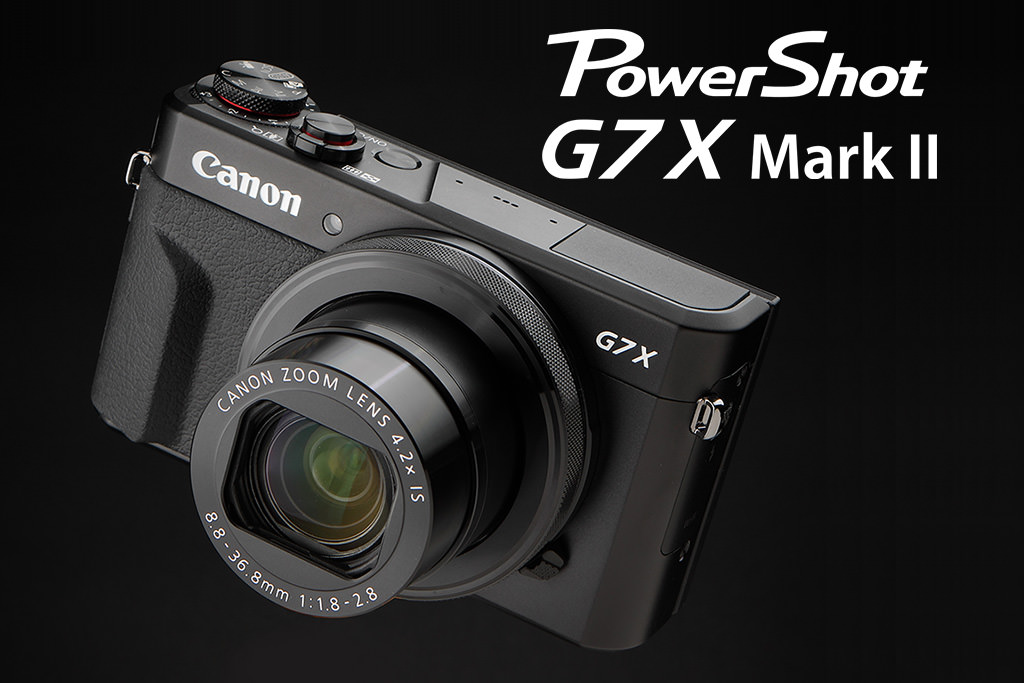PowerShot G7 X Mark II: Mainstay High-end Camera Boasting Great Advancements
The PowerShot G7 X Mark II is the high-end compact digital camera that is the successor to the popular PowerShot G7 X model that was released in 2014. Let’s take a look at the new improvements in both appearance and functionality that set it apart from its predecessor. (Reported by: Takeshi Ohura)

Specifications that are sure to greatly satisfy even the most discerning of users
In recent years, efforts have been made to ensure that compact digital cameras are equipped with more thorough depiction capabilities and functionality than smartphones, gaining them popularity among the most discerning of camera users.
The PowerShot G7 X Mark II is one such camera. As the successor to the PowerShot G7 X first released in October 2014, it is a full-spec compact digital camera boasting a 1.0 inch-type CMOS sensor, a large-diameter lens with 4.2x optical zoom, the latest image processor (DIGIC 7) as well as a multitude of features that will be familiar to EOS users.
Compactness inherited from the PowerShot G7 X
Let's first take a look at the camera’s exterior. In terms of size, the PowerShot G7 X Mark II is not much different from its predecessor. With dimensions (W × H × D) of 105.5 × 60.9 × 42.2mm and a weight of 319g (inclusive of the battery and memory card), it can be said that the PowerShot G7 X Mark II has inherited its compact design from its predecessor.






While the PowerShot G7 X has a metallic surface finish, the PowerShot G7 X Mark II has a resin surface designed to resemble grained leather and a new grip added to the front of the body, giving it a slightly different look and feel from its predecessor. These changes make it easier to handle, allowing you to enjoy shooting with a firmer, more stable grip.

The camera’s newly added grip, as well as a modest design that is exceptionally easy to handle. The resin finish designed to resemble grained leather is also a new addition.
Familiar operability, with a tilt-type monitor that can now be tilted downwards
Users of the PowerShot G7 X will be familiar with the layout of the controls. The PowerShot G7 X Mark II has inherited the characteristic stacked dial design, which consists of the mode dial stacked on top of the exposure compensation dial. However, the exposure compensation dial has been made larger to allow for easier operation.
One of the main differences that sets the two models apart is the range of the tilt-type monitor. The monitor on the PowerShot G7 X Mark II can be tilted up to 45 degrees downwards in addition to , making high-angle shooting in the horizontal position easier. The LCD monitor is a 3.0-inch touch panel LCD with a resolution of 1.04 million dots—essentially the same as that of the PowerShot G7 X.

The mode dial has been placed on top of the exposure compensation dial. The exposure compensation dial has been enlarged, and also has a suitable step-wise movement that makes it easier to operate with your right thumb.

The LCD monitor on the PowerShot G7 X can be tilted up to 180 degrees upward, while on the PowerShot G7 X Mark II, it can also be tilted up to 45 degrees downward.
The control ring at the base of the lens is also inherited from the PowerShot G7 X. However, you can now also set the operational feel of the control ring to either step or continuous control. The step-wise movement of the control ring can be switched on/off using a dedicated lever that can also be found at the base of the lens. You can set step control when assigning functions such as exposure settings, ISO speed, step zoom, and also continuous control for silent manual focus. This makes controls more intuitive and can be said to increase the operability of the control ring dramatically.

You can now select between step or continuous control for the control ring at the base of the lens. The protruding part as seen in the photo is the Step/Continuous Selection Lever.

The control ring setting screen allows you to assign functions such as ISO speed, focus, step zoom, and so on to the control ring. I would recommend setting those functions in combination with the step/continuous control function.

Shooting time screen when assigning the step zoom function to the control ring. The equivalent focal length is displayed at the bottom of the screen.
Another new feature of the PowerShot G7 X Mark II is that the menu display is similar to that of EOS-series cameras. EOS camera users will feel right at home with the menu operations. This fine-tuning can be said to deliver an even higher degree of completeness to the camera's operability.

The control keys on the rear side of the camera have not changed much from previous models, which reflects the camera’s stable operability.
The 1.0 inch-type sensor has become a standard
A quick glance reveals that the image sensor is a 1.0 inch-type CMOS sensor as mentioned above. This sensor allows for a large bokeh effect to more easily be obtained (apart from when performing close-up shooting) as compared to shooting with smartphone cameras,--and at a significant level as well.
Furthermore, it goes without saying that its tone reproducibility, high sensitivity characteristics, etc., are superior to those of a smartphone. Previously, compact digital cameras mostly used the 1/1.7 inch-type and 1/2.3 inch-type image sensors. However, there is an extremely high possibility that the 1.0 inch-type might become the standard of the future. The effective resolution of the 1.0 inch-type sensor on the PowerShot G7 X Mark II is approximately 20.1 megapixels.


The base ISO speed is ISO 125, with a maximum speed of ISO 12800. By employing a 1.0 inch-type CMOS sensor, even the high ISO range can be sufficiently utilised.

When the ISO speed is set to [Auto], you can set the range of change to "Standard", "Fast" or "Slow" simply and intuitively.

The camera is equipped with the Highlight Tone Priority mode that EOS users will be familiar with. This is an effective function for times when you want to preserve even a little bit of detail in areas with highlights.
First to be equipped with DIGIC 7 and Picture Style
Improvements to the camera’s image processor cannot be overlooked. The addition of the latest DIGIC 7 has not only led to improved tone reproducibility and high-sensitivity characteristics, but also to better image processing capability, with continuous shooting speed at up to 8 frames per second. Furthermore, the image processor is also responsible for image stabilisation, with control of the optical mechanism by a gyro sensor using Dual Sensing IS, which takes into account an algorithm based on the image data collected by the image sensor.
The correction effect uses a 4-step shutter speed. The maximum aperture of the lens is f/1.8-2.8, providing more than enough brightness as well as addressing camera shake. Moreover, DIGIC 7 can perform correction processing for diffraction, which causes the perceived resolution to be lower when the lens is stopped down, so users need to pay attention to this when narrowing the aperture to shoot scenery, etc.

The optical system remains unchanged from the PowerShot G7 X. You can obtain an equivalent angle of view ranging from 24 to 100mm. The number of correction steps for image stabilisation has been enhanced to 4.

An effective ND filter has been built into the camera for times when you want to shoot with the aperture fully open or for long exposure shooting . For normal use, you should be able to set this function to Auto mode without any problems.
Another new feature is Picture Style, which has been in use on EOS cameras for photo finishes. It is now possible to adjust parameters such as contrast and saturation (colour vividness), so that you can control the finish to suit your preferences, the same way you would do so on EOS series cameras. It goes without saying that if you were to use this camera as a sub-camera for an EOS camera, it’s convenient to match the finishing styles for a uniform look. Also, 14-bit recording is supported for RAW. The 1.0 inch-type sensor has margins that can be utilised for a finish that fully uses the tone reproducibility.
Lens suited to a high-end compact camera
The specifications of the lens include an equivalent angle of view of 24 to 100mm, and a maximum aperture of f/1.8 at the wide-angle end , and f/2.8 at the telephoto end. As a compact digital camera zoom lens, it is fairly bright, and can be expected to obtain a large bokeh with ease, depending on the conditions. With three aspherical lens elements , and one UD lens element ,as well as Canon's traditional Super Spectra coating and 9-blade iris diaphragm , the lens components are well-suited to a high-end compact digital camera.
Moreover, a closest focusing distance of 5cm is realised for the wide-end, and 40cm for the telephoto end. There was once a time when close-up shooting could not be carried out with a 1.0 inch-type-sensor compact, but this is no longer a concern.

With the lens extended. Power off

With the lens extended. Wide-angle end.

With the lens extended. Telephoto end. The start time is approximately 1.2 seconds.

Live View display. No information displayed.

Live View display. Information display 1.

Live View display. Information display 2 (grid lines / horizontal level / histogram ).

The Bracketing function also includes a Focus Bracketing function that changes the focus position while performing continuous shooting during manual focusing.

The camera has a built-in flash. While the guide number is unknown , the flash effective range is 0.5m to 7m for the wide-angle end, and 0.4m to 4m for the telephoto end.

A lithium-ion NB-13L battery is used. The camera can be used for up to 265 shots from full charge. (CIPA compliant/ with LCD monitor on)

A CB-2LH battery charger is included. Also supports USB charging.


Takeshi Ohura
Born in 1965 in Miyazaki Prefecture, Ohura graduated from the Department of Photography, College of Art, Nihon University. After his career with the editorial department of a motorcycle magazine and a design planning firm, he became a freelance photographer. He writes mainly for photography magazines based on his experience in using digital cameras for commercial shoots. Outside of work, he enjoys looking at photos and makes it a point to visit galleries regularly. Ohura is a member of the Camera Grand Prix Selection Committee.

Digital Camera Watch
Delivers daily news related to topics such as digital cameras and peripheral devices, and imaging software. Also publishes articles such as reviews on the use of actual digital camera models and photo samples taken using new models.
http://dc.watch.impress.co.jp/

































